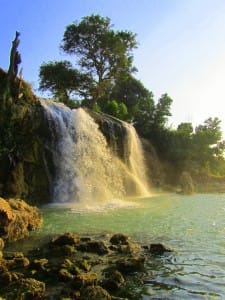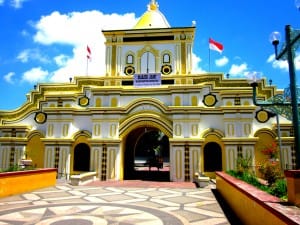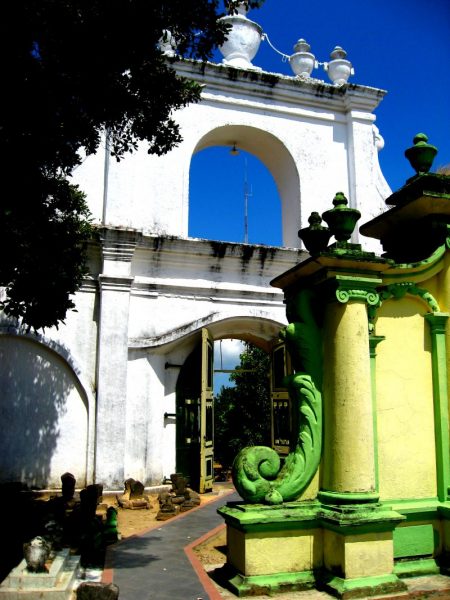The Javanese may tell you that the island of Madura – only 30 minutes away by ferry from Surabaya – is hot and arid and that the Madurese are rough and hot-tempered. They may even go so far as to say that there is nothing to see there. It’s not their idea of a place to go, but for the visitor who can put the stereotyping aside, it offers a very different, yet rewarding experience.
Madura, you might think, is just a small Java, but in fact it has a distinct culture and language of its own; incredible, given its close proximity to Java and small size: just 160km long by 30km north to south.
The island has had an uneasy relationship in the past with its big neighbour. In 1624, the Javanese Sultan Agung conquered the island and added it to the Mataram Empire, which at that time held sway over much of central and eastern Java. But by 1672 the Madurese Prince Trunojoyo had rid the island of the Javanese and it took several years and the VOC (Dutch East India Company) to put the recalcitrant island down. By 1705, the Dutch had control over the eastern half and by 1743 it was under full Dutch control. Not a particularly fertile island to exploit, it was, however, a source of colonial troops and the main supplier of lucrative salt to the Dutch colony. Nowadays, it is a mere province of Java, but the distinctions remain clear, even now that it is linked to Java by the Suramadu 5km-long bridge.The busiest connection is by ferry and crossings go on day and night and are full of Madurese living in Java. Commercial travellers with their vans make up the other passengers as most manufactured supplies come from Java. The women, more traditionally dressed than their Javanese counterparts, have stayed with their colourful sarongs and kelambi – blouses. They adorn their bodies in gold jewellery; their fine faces prove true their reputation for beauty.
On the Madura side the ferry docks in the port of Kamal, but there is little to detain us here and we motor on to Bangkalan, famous for its bull races held in August and September. It has a museum and one reasonable hotel. It is here that we can drive eastwards on the main road towards Sampang and Pamekasan, or as I would recommend, continue north to the less well-known but much more beautiful north coast road to Madura’s most interesting town, Sumenep.A brief stop at Arosbaya, half an hour north of Bangkalan, is very rewarding. In the 15th and 16th centuries, this was the centre of Madurese power and the royal Air Mata cemetery is a most peaceful place to stroll about. Here lie the remains of the Cakraningrat royal line and the graves are much revered. Ratu (Queen) Ibu’s grave of 1569 attracts pilgrims from all over Indonesia and is always surrounded by the faithful saying their prayers.
Madura, whilst arid in places, boasts a beautiful coastline and the nearest of the swimming beaches is at Siring Kemuning another 30km on. Vast and rather austere, it’s a popular Sunday picnic spot with locals. Like all of Madura’s beaches, it’s free of effluent and the sand is fine and golden.
At Klampis we reach the peak of our northern climb and turn eastwards along what is a good but narrow road that follows the northern coast. Estuaries are crammed full of colourful wooden boats, moored inland to shelter from the Java Sea. Fishing is the main occupation here, although lime is mined too, and at Pasean, beautifully wrought wooden vessels are being turned out to a design unchanged for centuries. Just near here the Air Terjun Toroan waterfall is well worth a stop to see a river cascade into the Java Sea.
At Pasongsongan, halfway to Sumenep, there are spectacular bays, which deserve a wider reputation as places to swim. The water is cool, the fine sand is overhung by trees which supply ample shade and the locals, whilst curious, keep their distance from sunbathing tourists who are few and far between.
A few kilometres on, Slopeng beach offers a better known bathing spot, well set up for the visitor with a row of warung offering seafood and kelapa muda (coconut drink), and a roofed viewing platform for those who wish to rest and take in the sea view. This area of Madura is the most fertile and the gradations of green are stunning. It is just beyond here at Ambunten that we take the southeast road to Sumenep, only 24km away. Or we can venture on eastwards to Lombang beach, considered to be Madura’s finest – a vast sweep of sand overhung with unique cemara udang fir trees and the safest swimming on the island.Sumenep shows a lot of civil pride; neat and tidy streets, shops painted in regulation yellow and the only town in Indonesia where becak must carry lights in the form of oil lamps. Everywhere can be reached by foot or less strenuous becak, and tourists attract considerable, but ever so polite interest. The 18th century gateway to the Jamik mosque dominates the main street. This stunning façade exhibits Chinese and European baroque influences, whilst the mosque behind, with its three-tiered roof, looks more Javanese.
Across from the Town Square lies Sumenep’s keraton (palace). The pavilion dates from 1763 and its wood panelled ceiling is hung with dozens of Dutch lamps that many an antique collector would love to own. A museum inside exhibits gifts given by European dignitaries over the centuries, including a 19th century dinner service with an image of the sultan in the centre of each plate, in the latest photo appliqué technique of the day. Taking a short walk down behind the keraton, we can see decaying Dutch period houses, once homes for the extended family of the sultan and the prosperous Dutch. Crying out for restoration, their colonnaded verandahs still give a splendid sense of grandeur.
Just 2km from the town, the royal graveyard of Asta Tinggi is well worth a detour. Situated on a hill with a fine view over the town, its 18th century façade looks very European and the graves and mausoleums here are much revered by locals.
It is possible to drive 30 minutes to Kalianget, the old salt town, and take a boat to the neighbouring island, Puteran. These can be hired at the wharf. The island is untouched by modernity, is quaint and very friendly. Seldom do tourists get here.A weekend has been spent just a stone’s throw from the hustle and bustle of Surabaya, but in another more tranquil world.
Province: East Java
How to get there: Take the ferry from Surabaya’s Tanjung Perak port, or the Suramadu bridge.
Where to stay: Bangkalan: Ningrat Hotel, Jl. K H Moh Holil 113.
Tel: (031) 3095388; 3095507. Sumenep: Hotel C1, Jl. Sultan Abdurrahman. Tel: (0328) 674368.




